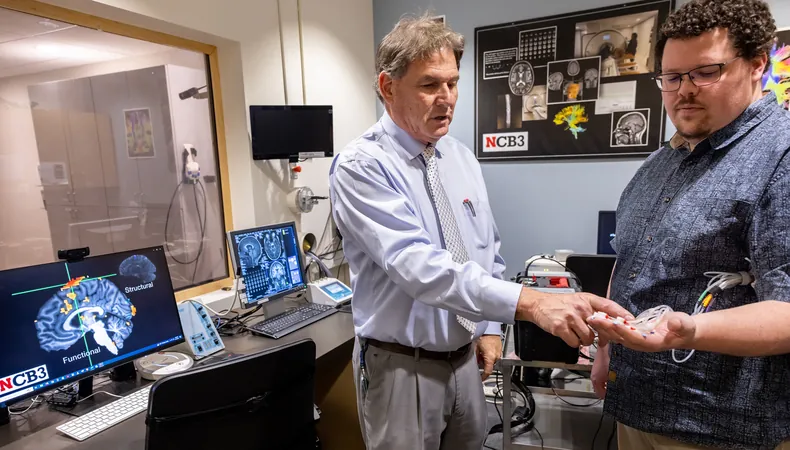
Revolutionary New Device Promises to Transform Stroke Treatment
2025-04-03
Author: Jia
Every year, over 795,000 adults in the United States experience a stroke, and globally, one in four individuals will encounter this life-threatening condition during their lifetime. Early intervention is critical, significantly reducing the risks of death and long-term disability.
Introduction of the pTACS Somatosensory Biomedical Device
Now, researchers at the University of Nebraska, led by Steven Barlow, have developed a revolutionary new treatment device—the pTACS Somatosensory Biomedical Device. This portable innovation aims to enhance treatment options for stroke patients, making it a potential game changer in rehabilitation clinics, emergency rooms, and even ambulances.
“This device is not only low-cost but also highly accessible, enabling numerous rehabilitation centers nationwide and beyond to utilize this crucial technology,” stated Barlow, a professor specializing in communication disorders and a key figure in neuroscience research. Stroke has moved to the forefront as a leading health crisis worldwide, overtaking other diseases in terms of prevalence.
Technological Features
The innovative pTACS integrates a sophisticated pneumatic controller with a microprocessor, all housed in a compact black toolbox. It operates on rechargeable lithium-ion batteries, similar to those found in smartphones. This design not only enhances portability but also ensures precision in therapeutic delivery.
Evolution from Previous Technologies
The pTACS is a critical evolution from Barlow's prior invention, the Galileo device, which focused on using micro-pulses of air in stroke therapy. After extensive trials at the University of Nebraska–Lincoln, Barlow and his colleague Jacob Greenwood, a biomedical engineering doctoral candidate, have secured a U.S. patent for this promising device.
Mechanism of Action
Utilizing non-invasive brain stimulation techniques, pTACS employs rapid air pulses transmitted through small tubes into touch capsules positioned on various body parts (hands, face, feet). This method triggers neural responses that have been linked to increased blood flow in the damaged areas of the brain.
Previous studies involving animal models from the University of California, Irvine, highlighted the importance of timing in therapy. Deliberate somatosensory stimulation can prevent brain cell death and inhibit the progression of cerebral infarcts during crucial recovery periods.
Targeted Therapy Approaches
Barlow explained, “By strategically stimulating different areas of the body, we can target specific sections of the brain due to the interconnected nature of sensory pathways.”
Operational Management
The device's operation is effectively managed via a small computer that allows clinical staff to select therapy protocols customized through Barlow's extensive research and clinical trials.
Path to FDA Approval
The recent patent acquisition is an important milestone towards obtaining FDA approval for the device. Barlow is also in collaboration with NUtech Ventures to establish a biomedical startup dedicated to manufacturing and distributing the pTACS. His previous successes, including the commercialization of the NTrainer System 2.0—now internationally recognized as the Kangaroo NTrainer System—provide a foundation for this new venture.
Beyond Stroke Treatment
Beyond stroke treatment, Barlow and his team are actively exploring the device's potential applications in post-stroke rehabilitation and therapeutic communication strategies for individuals with conditions like autism spectrum disorder.
In clinical settings, even patients who are years post-injury show remarkable functional improvements through pTACS therapy, indicating the enduring potential of this approach. “This therapy could be effectively administered by trained professionals, including speech-language pathologists and physical therapists,” Barlow noted.
Current Research Efforts
Current research efforts are underway, employing pTACS in MRIs to stimulate mechanosensory nerve endings in the feet, thereby enhancing gait and balance—an exciting development in understanding the neuroplasticity of the brain and its recovery mechanisms.
Looking Forward
Looking ahead, Barlow is optimistic: “Our research trajectory is promising, and our team is vibrant, with a wealth of student and investigator engagement.” The future of stroke treatment with the pTACS Somatosensory Biomedical Device looks bright, heralding a new era of effective interventions that could reshape recovery outcomes for countless patients worldwide.

 Brasil (PT)
Brasil (PT)
 Canada (EN)
Canada (EN)
 Chile (ES)
Chile (ES)
 Česko (CS)
Česko (CS)
 대한민국 (KO)
대한민국 (KO)
 España (ES)
España (ES)
 France (FR)
France (FR)
 Hong Kong (EN)
Hong Kong (EN)
 Italia (IT)
Italia (IT)
 日本 (JA)
日本 (JA)
 Magyarország (HU)
Magyarország (HU)
 Norge (NO)
Norge (NO)
 Polska (PL)
Polska (PL)
 Schweiz (DE)
Schweiz (DE)
 Singapore (EN)
Singapore (EN)
 Sverige (SV)
Sverige (SV)
 Suomi (FI)
Suomi (FI)
 Türkiye (TR)
Türkiye (TR)
 الإمارات العربية المتحدة (AR)
الإمارات العربية المتحدة (AR)